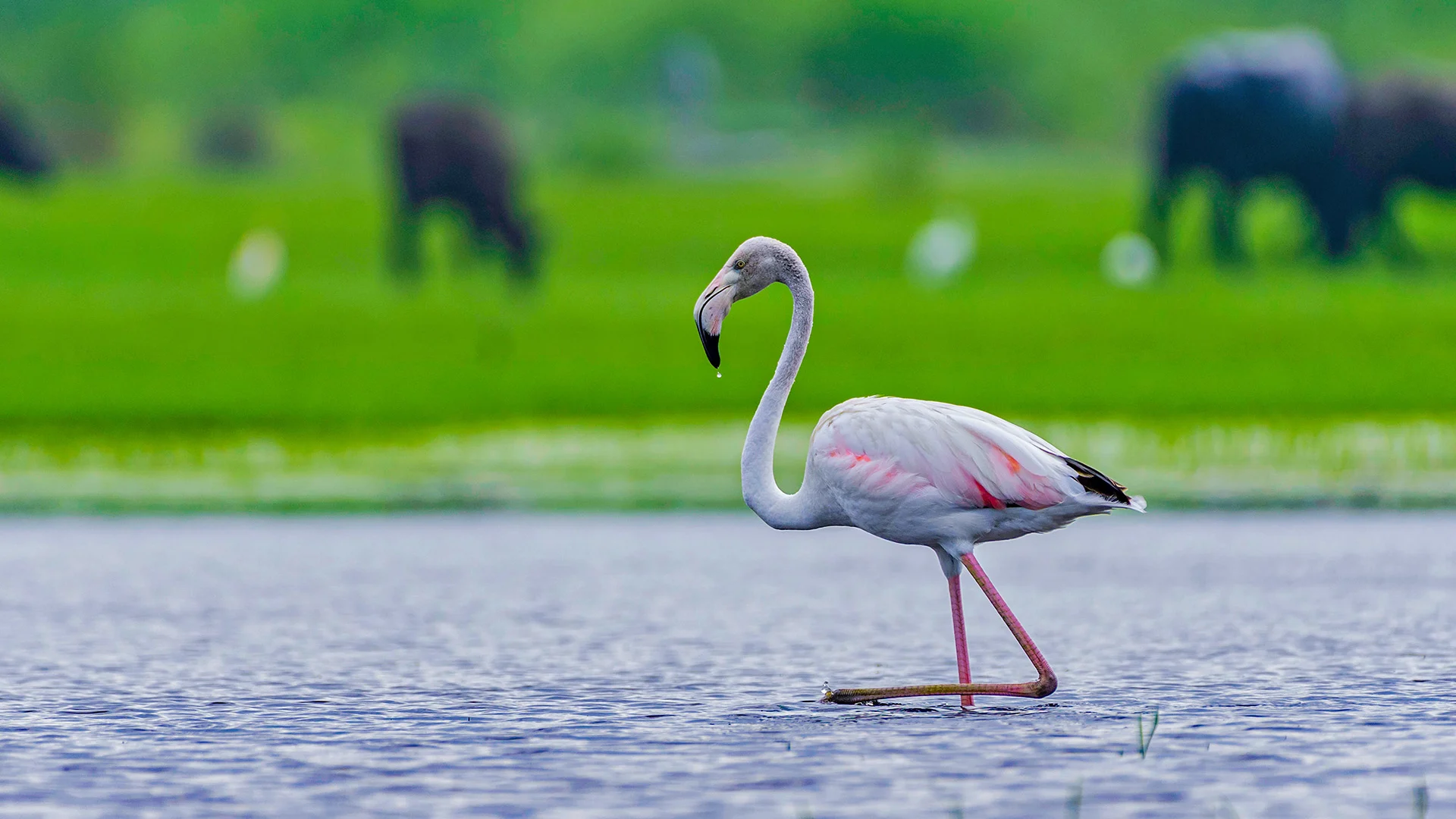Dhanauri and Asan Wetlands
Wetlands are one of the most important ecosystems, playing a crucial role in biodiversity conservation, climate regulation, and hydrological balance. The Dhanauri Wetlands in Uttar Pradesh and Asan Wetland in Uttarakhand have been in the news due to conservation concerns and legal battles.
I. DHANAURI WETLANDS (Uttar Pradesh)
- Why is Dhanauri Wetland in the News?
- NGT Intervention:
- A plea was filed in the National Green Tribunal (NGT) to halt the construction of the Noida International Airport (Jewar Airport) until Dhanauri Wetlands is granted protection status.
- The NGT has given the Uttar Pradesh government four weeks to report on the status of designating Dhanauri as a Ramsar site.
- Pending Ramsar Site Status:
- The Uttar Pradesh Wetland Authority has been reviewing a proposal to designate Dhanauri as a Ramsar site since August 2022.
- Yamuna Expressway Industrial Development Authority (YEIDA), which owns the land, has provided a No-Objection Certificate (NOC) for granting Ramsar site status.
- Wildlife Institute of India (WII) Report:
- Recommends urgent declaration of Dhanauri as a Wildlife Sanctuary or Conservation Reserve.
- NGT Intervention:
- Location & Physical Features
- Location:
- Greater Noida, Gautam Buddha Nagar district, Uttar Pradesh.
- Lies 15 km from the Yamuna River and is near the Okhla Bird Sanctuary and Surajpur Wetland.
- Spans across 98 hectares covering Dhanauri, Thasrana, and Aminpur Bangar villages in Dankaur Tehsil.
- Type:
- A natural wetland ecosystem situated within the Yamuna River floodplains.
- Composed of marshlands, seasonal water bodies, and aquatic vegetation.
- Location:
- Biodiversity Significance
- Recognized as an Important Bird Area (IBA) by BirdLife International.
- Home to over 217 bird species, including:
- Sarus Crane (Antigone antigone) – The state bird of Uttar Pradesh (~150 recorded).
- Migratory birds (November–March):
- Hosts over 50,000 migratory waterfowls during peak migration season.
- Other key bird species include:
- Common teal, Mallard, Northern Pintail, Greylag geese, Bar-headed geese.
- Woolly-necked stork, Black-necked stork, Painted Stork, Eurasian marsh harrier.
- Tallest flying bird in the world (~1.8m tall).
- IUCN Status: Vulnerable.
- Three subspecies of Sarus Crane:
- Indian Sarus Crane (most numerous).
- Eastern Sarus Crane (Southeast Asia).
- Australian Sarus Crane (Australia).
- Ecological Importance
- Groundwater Recharge: Helps maintain local water tables by acting as a natural aquifer.
- Carbon Sink:Absorbs CO₂ and regulates local climate
- Biodiversity Hub: Provides habitat for birds, amphibians, and aquatic life.
- Flood Prevention: Acts as a buffer zone, preventing flash floods and excessive water runoff.
- Threats & Conservation Efforts
Major Threats:
- Urbanization & Infrastructure Development:
- Proximity to Jewar Airport (Noida International Airport) poses a major threat.
- Large-scale construction, pollution, and habitat destruction.
- Encroachment & Illegal Activities:
- Unregulated farming and land conversion for commercial use.
- Waste dumping and industrial pollution affecting water quality.
- Climate Change:
- Rising temperatures, erratic rainfall, and water level fluctuations impact the wetland ecosystem.
- Urbanization & Infrastructure Development:
Key Facts about Sarus Crane:
Conservation Efforts:
- Pending Ramsar Site Status: Proposal submitted to Uttar Pradesh Wetland Authority (2022).
- NGT Intervention: Legal proceedings to protect the wetland before airport construction.
- Wildlife Institute of India Recommendation: Urges urgent designation as a Wildlife Sanctuary or Conservation Reserve.
Way Forward:
- UP Government must expedite Ramsar Site notification.
- Eco-tourism development while ensuring conservation.
- Strengthen community participation and scientific monitoring.
II. ASAN WETLAND (Uttarakhand)
- Why is Asan Wetland in the News?
- Asian Waterbird Census (2025):
- Recently hosted the Asian Waterbird Census (AWC), recording 5,225 birds across 117 species.
- First Ramsar Site of Uttarakhand:
- Designated a Ramsar site in 2020, receiving global recognition for conservation.
- Important migratory bird habitat under the Central Asian Flyway.
- Asian Waterbird Census (2025):
- Location & Physical Features
- Location:
- Dehradun district, Uttarakhand, near the Himachal Pradesh border.
- Lies at the confluence of the Asan River and the Eastern Yamuna Canal.
- Created due to damming of Asan River at the Dhalipur Barrage (1967) for hydroelectric power generation.
- Now a protected wetland under the Ramsar Convention.
- Location:
- Biodiversity & Ecological Importance
- Home to 330+ bird species, including:
- Critically endangered: White-rumped vulture, Red-headed vulture, Baer’s pochard.
- Migratory species: Brahminy duck, Red-crested pochard, Gadwall, Mallard (from Central Asia).
- Fish Species: Hosts 49 species, including the endangered Putitor Mahseer.
- Wetland Ecosystem Services:
- Supports hydrological cycles & biodiversity.
- Essential habitat for resident & migratory birds.
- Home to 330+ bird species, including:
- Conservation Measures & Threats
Conservation Measures:
- Declared a Ramsar site in 2020, gaining international protection.
- Regular monitoring through the Asian Waterbird Census (AWC).
- Strict guidelines for wetland management and habitat protection.
- Encroachment & Pollution: Industrial development affecting water quality.
- Hydropower Project Impact: Affects water levels and habitat stability.
- Sustainable eco-tourism with wetland conservation.
- Strict enforcement of Ramsar conservation guidelines.
- Local community participation in wetland management.
Threats:
Way Forward:

Wetland Conservation Focus Initiatives in India
I. Wetland Conservation: Importance & Current Status in India
- Why Wetland Conservation is Crucial?
- India has 4.63% of its total land area under wetlands (NCSCM, 2023).
- Wetlands provide water filtration, flood control, biodiversity support, and carbon sequestration.
- Threats to Wetlands:
- Encroachment & urbanization (e.g., Pallikaranai Wetlands, Chennai).
- Pollution (e.g., Bellandur Lake, Bengaluru).
- Climate change-induced droughts & flooding.
- Wetlands of International Importance (Ramsar Sites in
India)
- India currently has 80 Ramsar sites (as of 2025), covering 1.3 million hectares.
- Recent Additions (2024-25):
- Dhanauri Wetlands (Uttar Pradesh) – Awaiting final approval.
- Parvati Arga Wetland (UP), Sirpur Wetland (MP), and others.
II.Key Wetland Conservation Initiatives in India
- Amrit Dharohar Initiative (2023-25)
- Launched under Budget 2023-24 to promote wetland conservation and sustainable eco-tourism.
- Key objectives:
- Conservation of Ramsar sites & biodiversity hotspots.
- Livelihood generation through sustainable tourism.
- Community-based conservation programs.
- National Plan for Conservation of Aquatic Ecosystems (NPCA)
- Centrally sponsored scheme for wetland and lake conservation.
- 2024-25 updates:
- ₹700 crore allocated for wetland restoration.
- Focus on restoring polluted and degraded wetlands.
- Wetlands (Conservation & Management) Rules, 2017 – Strengthened in
2024
- Regulates wetlands across India, barring river channels & coastal wetlands.
- 2024 Amendments:
- Stronger penalties for encroachment.
- Community participation mandated in wetland management.
- Ramsar Site Expansion Program (2024-25)
- India aims to reach 100 Ramsar sites by 2027.
- New focus regions:
- Urban wetlands (e.g., Deepor Beel, Assam).
- Coastal wetlands (e.g., Chilika Lake, Odisha).
- MISHTI (Mangrove Initiative for Shoreline Habitats & Tangible Incomes)
- Announced in Budget 2023-24 to expand mangrove wetlands in India.
- 2024-25 progress:
- Restoration of 5,000 hectares of mangrove wetlands in West Bengal, Odisha, Tamil Nadu, and Gujarat.
- Integrated Wetland Management in Ganga Basin – Namami Gange Initiative
- Focus on wetland restoration in Ganga floodplains.
- 2024-25 progress:
- 150 wetlands restored along the Ganga river.
- Dolphin population increased from 3,700 (2019) to 4,100 (2024).
III.New Ramsar Sites & Regional Wetland Conservation Focus (2024-25)
- Dhanauri Wetlands (Uttar Pradesh) – Proposed Ramsar Site
- Biodiversity hotspot with over 217 bird species, including the Sarus Crane.
- Threat: Encroachment due to Noida International Airport project.
- Status: Pending Ramsar approval; NGT intervention.
- Asan Wetland (Uttarakhand)
- First Ramsar site of Uttarakhand (2020).
- 2024-25 updates: Strengthened monitoring under Asian Waterbird Census (AWC).
- Loktak Lake (Manipur) – India’s Only Floating Wetland
- Home to the endangered Sangai deer.
- Threats: Pollution, encroachment, hydropower projects.
- 2024-25: Strengthened community-based conservation programs.
- Deepor Beel (Assam) – Key Urban Wetland
- Vital for Guwahati’s water security.
- Threat: Encroachment & pollution from human settlements.
- 2024-25: New sewage treatment plant approved.
IV. Challenges in Wetland Conservation
| Challenge | Impact | Example |
|---|---|---|
| Encroachment & Land-Use Change | Loss of wetland habitat | Pallikaranai Marshland (Chennai) |
| Pollution & Sewage Dumping | Water contamination, biodiversity loss | Bellandur Lake (Bengaluru) |
| Climate Change | Drying of wetlands, erratic rainfall | Sambhar Lake (Rajasthan) |
| Lack of Integrated Policy | Poor management, conflicting land use policies | Deepor Beel (Assam) |
V.Strengthening Wetland Conservation in India
- Policy & Governance Enhancements
- Stronger implementation of Wetlands (Conservation & Management) Rules, 2017.
- Faster approval of Ramsar sites and conservation reserves.
- Community Involvement & Sustainable Eco-Tourism
- Amrit Dharohar model: Encouraging local participation & livelihood generation.
- Example: Sustainable tourism in Chilika Lake (Odisha).
- Scientific Research & Monitoring
- Integration with GIS & Remote Sensing for real-time wetland monitoring.
- Citizen science programs (like Asian Waterbird Census).
- Strengthening International Commitments
- Aligning with Ramsar Convention’s “Wise Use” principles.
- Expanding cooperation with Wetlands International, IUCN, and UN agencies.













